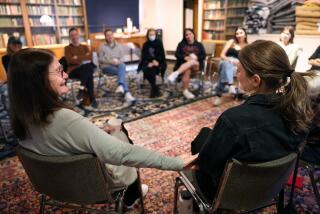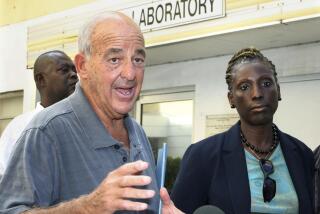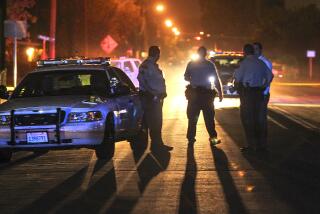S.D. Medical Examiner’s Investigator Learns to Live Life of Dealing With Death
For Robert Engel, New Year’s Day was one like any other--a day of death.
By mid-morning, he already had viewed the body of a man who had hanged himself in the closet of his Mission Valley hotel room. Then, just before noon, he was on the scene of a crash on Highway 163 in which a young restaurant worker’s car had rammed a eucalyptus tree head-on, horribly disfiguring his head and killing him instantly.
In a matter of minutes, Engel had examined the body before it was taken off to the county morgue and had talked with police officers and witnesses left on the scene.
Eventually, however, someone had to inform the man’s family. And like it has so many times over the last 16 years, that thankless task fell to Bob Engel.
He’s one of 13 investigators for the San Diego County Medical Examiner’s office--a job that makes him equal parts detective, counselor and long-distance driver as he ranges across the vast county limits looking at death.
On each scene, often stepping past the police crime-scene tape, he asks not whodunit but how it occurred, taking notes and pictures that--along with the subsequent autopsy--are used by a pathologist to determine an exact cause of death.
Then, fresh from the often-grisly sights and smells of a death scene, Engel must bring the tragic news home to yet another inconsolable family.
In an increasingly violent San Diego--where murder reached a near record level in 1990--Engel is one of a cadre of professionals who translate harsh statistics into human terms, to explain to a victim’s family how things had suddenly gone so terribly wrong.
And last year, the office was restructured, with a medical doctor replacing the bureaucrat who had held the top administrative post. The move quieted critics who had argued that the old coroner’s system was archaic.
But for all the changes behind the desks, the business of probing the causes of death for investigators like Engel remained fundamentally unchanged in 1990.
During the year, the county medical examiner’s office was called in to investigate 2,700 cases in which there was a suspicion that a person died of something other than natural causes or in deaths where there was no attending doctor.
That includes 245 homicides countywide--stabbings, shootings and strangulations--and more than 435 traffic and pedestrian fatalities.
There were also hundreds of suicides and household accidents such as pool drownings, falls from ladders and carbon monoxide poisonings. There were fire-related deaths, train accidents, airplane crashes and industrial mishaps such as electrocutions, explosions and people crushed by falling objects.
That’s an average of eight deaths a day for which investigators must help determine a cause so that a death certificate can be signed.
And while he has eventually become used to dealing with the dead, Engel says he has never gotten comfortable with the survivors--the family members he must not only inform, but also possibly console.
Pressing that doorbell, Engel says, is to enter a minefield of often-explosive emotional reactions to his messages of mortality.
“It’s the most difficult part of my job, day in and day out,” Engel said. “You can get used to the sight of the mutilated bodies, the foul and unpleasant odors. But you never get used to offering up the bad news to the family. You just never do.”
Over the years, Engel has witnessed myriad reactions.
“Some family members will take the news silently,” he said. “They’ll look at you very pleasantly and say something like ‘Gee, I’d hate to have your job.’
“Other times, you see a look of rage pass over their face and they’ll say ‘Why are you telling me this? I know my son’s not dead.’ It’s almost like they’re being angry with you for lying to them.”
Once, a father became so enraged over the news of his son’s death that he climbed over his office desk to attack the investigator. Other times, Engel and others have had to revive people who have passed out at the news.
But Engel, a shy man with gray hair and a quickly fading smile, has developed some time-tested techniques in dealing with grieving families.
Often, he will first knock on a neighbor’s door to locate a close friend of the family to accompany him to the home. That way, he says, there is someone close to act as an immediate emotional cushion when the hard news hits.
“At first, I usually don’t tell a family who I am,” he said. “I say that I’m from the county and then I offer them details such as the fact that their family member was driving on I-5 that afternoon in a red Toyota.”
Eventually, he breaks the news that the person is dead.
“Often, the family member is still looking at me blankly, so I’ll have to say it outright, something like ‘I hate to tell you this, but your son is dead,’ ” Engel said.
“To tell them right off is often too much of a shock to the system. When they hear the words, they usually break down so bad they don’t hear anything else you say.”
Once, at the home of an East County man who had died in a factory accident, Engel was drawn into a spontaneous prayer ceremony.
“The family just formed a circle and held hands, me included, and prayed for their breadwinner who didn’t come home that day,” he said. “I remember that it broke me up pretty badly.”
More often, though, his visits become scenes of frustration and confusion. Like the one he made to the Logan Heights home of the 28-year-old restaurant worker on New Year’s Day.
At the door, he showed several of the dead man’s identification cards and waited for the worst.
“There was only one teen-aged brother who could speak English,” Engel recalled. “So I had to stand by and watch as he relayed the word to the rest of the family. I felt so helpless. Pretty soon, the whole house was in chaos and there was nothing I could say or do to help.”
Even worse were the mass deaths of innocents--the PSA airline crash in 1978 and the San Ysidro massacre in 1984.
But the cases that upset him the most, he says, are those involving the death of children. That’s when the 57-year-old Engel, a grandfather of four, feels the closest to the families he informs.
“Children are just so innocent, they have their whole lives ahead of them” he said. “When I must deal with a child’s death, that’s when I’m most able to put myself in the shoes of the family.
“I’ve just seen so many of the positions that infants can get in to asphyxiate themselves, like when a box lid drops on their head when they’re looking inside, or when they fall into a pail of wash water or wrap a Venetian blind cord around their neck.
“These things happen so quickly when they’re out of their mother’s sight for such a brief period of time. And then you have to watch as the mothers blame themselves. It’s not easy.”
Some days, the foreboding for death and violence is so strong, Engel says he feels like staying in bed.
And over the years, after witnessing fatal accidents involving horses, motorcycles and dune-buggies, he had to fight the urge to be overly protective with his children--an urge his wife, Marlene, helped him overcome.
Witnessing the throes of death over 16 years has changed him in other ways, Engel says.
“In this profession, we see so many sudden, unexpected deaths that you realize how temporary life is,” he said. “It’s changed me over the years, to the point where anything I want to say to somebody, I know that today is the day to do it.”
He has become less materialistic. And more religious. “I just find myself stopping along the way to appreciate that beautiful sunset or sunrise.”
The investigators in Engel’s office--twelve men and one woman--come from different backgrounds. Some are ex-nurses. Others, like him, were former morticians who believed they could do more public good working as a medical examiner’s investigator.
Throughout the year, they play psychologist for one another, talking openly about difficult death scenes, often assuming one another’s cases involving children or particularly violent deaths when the stress begins to build on any one of them.
But at the end of a particularly violent day, Engel is often edgy. And he can’t understand why his wife sometimes gets so upset over some small domestic setback.
“After living with someone for 36 years, you just tell when they need to talk,” said Marlene Engel. “For years, when the children were home, Bob wouldn’t talk about his job. But after they left, he began to open up. I guess he didn’t feel like he had to keep it from the family any longer.”
She remembers the days following the PSA crash and the San Ysidro massacre, seeing in her husband’s face how the violence had affected him. “Even today, when anyone mentions those two events, you can see in his eyes that it still bothers him.”
But he still doesn’t confess all. On weekend drives, when passing an intersection or address where he has in the past visited some ghastly death scene, Engel doesn’t bother pointing them out. Some things, he says, are better left unsaid.
Like others who regularly see violence--doctors, highway patrolmen or homicide detectives--Engel and other medical examiner investigators have devised ways to safeguard their emotions.
Some use humor. Engel says he has come to terms with death.
“For me, after the death takes place, the body loses its identity as a person and becomes more of an object to be examined to determine its cause of death,” he said. “It’s almost like a car is to an auto mechanic. He’s just anxious to pop the hood open and see why it quit.”
When Engel is alone with a corpse, he no longer feels as though there are two people in the room. As he talked, he walked the hallways of the medical examiner’s office in Clairemont Mesa, past stainless steel gurneys with thick black rubber wheels and past brightly-lit operating rooms that smelled of disinfectant and chemicals.
Then he opened a refrigerator where bodies are stored until autopsies are completed, revealing blue toes and fingers under frigid white sheets. “To many people this is a grim sight,” he said. “To me, it doesn’t mean a thing. It’s just a refrigerator.”
Earlier in the day, Engel had visited the scene in Normal Heights where a man had died in his car, which had been left running with the heater on full blast in the alley behind his home.
While the man had been dead for less than a day, the heater had charred the body so that it appeared mummy-like. As two San Diego police officers cracked jokes and stole glances at the corpse, Engel moved about with the detachment of an insurance investigator inspecting a bent fender.
On murder investigations, the police department becomes the lead investigative agency. But with deaths that are presumed natural, examiners such as Engel take charge of the death scene.
The past year, he said, has brought a new-found respectability for his office.
With the hiring last December of Dr. Brian Blackbourne, 52, the former chief medical examiner for Massachusetts, the office has had a full-fledged physician to oversee laboratory work and autopsies conducted by its five pathologists, as well as sign all death certificates and provide final say on cause of death.
Since then, Engel says, the office has been free from the charges of faulty investigations that plagued the old coroner’s system, which was run by a licensed embalmer and mortician.
But the stress of manning the medical examiner’s office seven days a week--and changing shifts every third month--has taken its toll on the small staff, Engel says.
And so Bob Engel breathes a sigh of relief each day when he heads toward his rural Spring Valley home complete with horses, leaving behind the death and mayhem of the big city.
Four years from now, Engel plans to retire to that 1-acre spread. Then he’ll no longer have to face the uncertainty of approaching a front door without knowing whether the family member within is a wife home alone, a grandfather in failing health or an innocent child.
“Sometimes, when I pull up, my palms get sweaty with the uncertainty,” he said. “You just never know what you’re going to find in one of those visits. And that uncertainty eventually takes its toll. It’s not something I’ll ever miss.”
More to Read
Sign up for Essential California
The most important California stories and recommendations in your inbox every morning.
You may occasionally receive promotional content from the Los Angeles Times.











